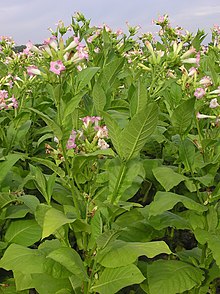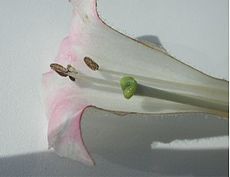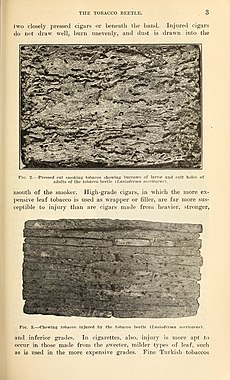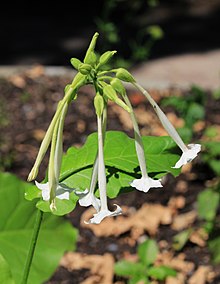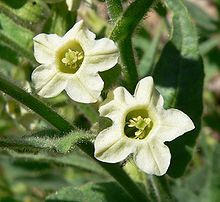
Petunia is a genus of 20 species of flowering plants of South American origin. The popular flower of the same name derived its epithet from the French, which took the word pétun, 'tobacco', from a Tupi–Guarani language. A tender perennial, most of the varieties seen in gardens are hybrids.

The Sphingidae are a family of moths commonly called sphinx moths, also colloquially known as hawk moths, with many of their caterpillars known as "hornworms"; it includes about 1,450 species. It is best represented in the tropics, but species are found in every region. They are moderate to large in size and are distinguished among moths for their agile and sustained flying ability, similar enough to that of hummingbirds as to be reliably mistaken for them. Their narrow wings and streamlined abdomens are adaptations for rapid flight. The family was named by French zoologist Pierre André Latreille in 1802.
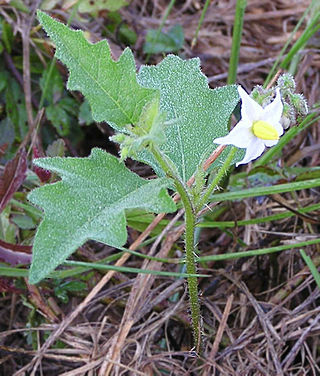
Solanum carolinense, the Carolina horsenettle, is not a true nettle, but a member of the Solanaceae, or nightshade family. It is a perennial herbaceous plant, native to the southeastern United States, though its range has expanded throughout much of temperate North America. The plant is an invasive in parts of Europe, Asia, Africa and Australia. The stem and undersides of larger leaf veins are covered with prickles.
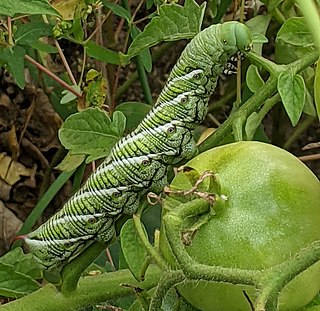
Manduca sexta is a moth of the family Sphingidae present through much of the Americas. The species was first described by Carl Linnaeus in his 1763 Centuria Insectorum.

Nicotiana glauca is a species of flowering plant in the tobacco genus Nicotiana of the nightshade family Solanaceae. It is known by the common name tree tobacco. Its leaves are attached to the stalk by petioles, and its leaves and stems are neither pubescent nor sticky like Nicotiana tabacum. It resembles Cestrum parqui but differs in the form of leaves and fusion of the outer floral parts. It grows to heights of more than two meters.

Nicotiana sylvestris is a species of flowering plant in the nightshade family Solanaceae, known by the common names woodland tobacco, flowering tobacco, and South American tobacco. It is a biennial or short-lived perennial plant in the tobacco genus Nicotiana, native to the Andes region in Argentina and Bolivia, in South America.

Manduca quinquemaculata, the five-spotted hawkmoth, is a brown and gray hawk moth of the family Sphingidae. The caterpillar, often referred to as the tomato hornworm, can be a major pest in gardens; they get their name from a dark projection on their posterior end and their use of tomatoes as host plants. Tomato hornworms are closely related to the tobacco hornworm Manduca sexta. This confusion arises because caterpillars of both species have similar morphologies and feed on the foliage of various plants from the family Solanaceae, so either species can be found on tobacco or tomato leaves. Because of this, the plant on which the caterpillar is found does not indicate its species.

Cutworms are moth larvae that hide under litter or soil during the day, coming out in the dark to feed on plants. A larva typically attacks the first part of the plant it encounters, namely the stem, often of a seedling, and consequently cuts it down; hence the name cutworm. Cutworms are not worms, biologically speaking, but caterpillars.
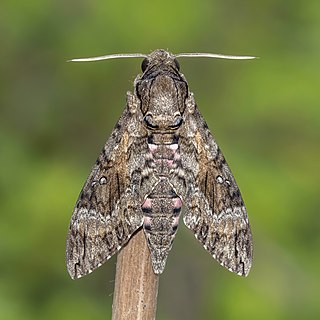
Agrius cingulata, the pink-spotted hawkmoth or sweetpotato hornworm, is a moth in the family Sphingidae. The species was first described by Johan Christian Fabricius in 1775.
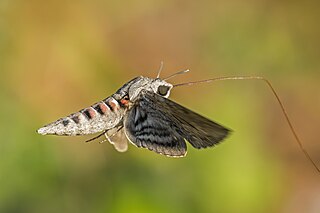
Agrius convolvuli, the convolvulus hawk-moth, is a large hawk-moth. It is common throughout Europe, Asia, Africa, Australia and New Zealand, partly as a migrant. In New Zealand, it is also known as the kumara moth, and in the Māori language as hīhue.

Anabasine is a pyridine and piperidine alkaloid found in the Tree Tobacco plant, as well as in the close relative of the common tobacco plant. It is a structural isomer of, and chemically similar to, nicotine. Its principal (historical) industrial use is as an insecticide.

Manduca blackburni, the Hawaiian tomato hornworm, Hawaiian tobacco hornworm or Blackburn's sphinx moth, is a moth in the family Sphingidae.
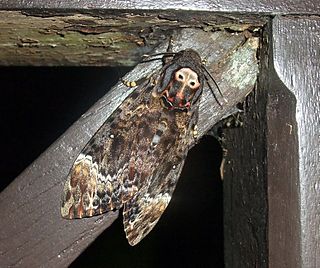
Acherontia lachesis, the greater death's head hawkmoth or bee robber, is a large sphingid moth found in India, Sri Lanka and much of the Oriental region. It is one of the three species of death's-head hawkmoth genus, Acherontia. The species was first described by Johan Christian Fabricius in 1798. It is nocturnal and very fond of honey; they can mimic the scent of honey bees so that they can enter a hive unharmed to get honey. Their tongue, which is stout and very strong, enables them to pierce the wax cells and suck the honey out. This species occurs throughout almost the entire Oriental region, from India, Pakistan and Nepal to the Philippines, and from southern Japan and the southern Russian Far East to Indonesia, where it attacks colonies of several different honey bee species. It has recently become established on the Hawaiian Islands.

Ephestia elutella, the cacao moth, tobacco moth or warehouse moth, is a small moth of the family Pyralidae. It is probably native to Europe, but has been transported widely, even to Australia. A subspecies is E. e. pterogrisella.
Nicotiana tomentosiformis is a perennial herbaceous plant. It is a wild species of tobacco native to the Yungas Valley region in the eastern piedmont of the Andes Mountains, primarily in Bolivia.
Nicotiana otophora is a perennial herbaceous plant. It is a wild species of tobacco native to the Andes Mountains of Bolivia and Argentina.

Nicotiana attenuata is a species of wild tobacco known by the common name coyote tobacco. It is native to western North America from British Columbia to Texas and northern Mexico, where it grows in many types of habitat. It is a glandular and sparsely hairy annual herb exceeding a meter in maximum height. The leaf blades may be 10 centimetres (4 in) long, the lower ones oval and the upper narrower in shape, and are borne on petioles. The inflorescence bears several flowers with pinkish or greenish white tubular throats 2 to 3 centimetres long, their bases enclosed in pointed sepals. The flower face has five mostly white lobes. The fruit is a capsule about 1 centimetre long.
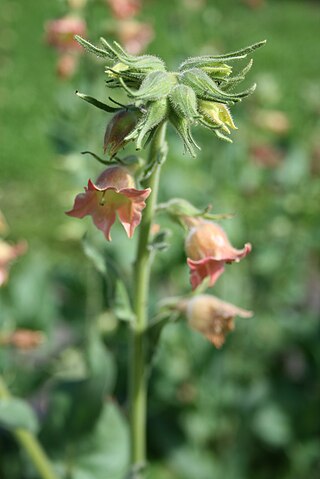
Nicotiana glutinosa is a species of tobacco plant that is economically important in tobacco hybrids. N. glutinosa is native to western South America, including Bolivia, Ecuador, and Peru. It is a model organism for the study of Tobacco mosaic virus resistance in tobacco.

The Solanaceae, or the nightshades, are a family of flowering plants that ranges from annual and perennial herbs to vines, lianas, epiphytes, shrubs, and trees, and includes a number of agricultural crops, medicinal plants, spices, weeds, and ornamentals. Many members of the family contain potent alkaloids, and some are highly toxic, but many—including tomatoes, potatoes, eggplant, bell and chili peppers—are used as food. The family belongs to the order Solanales, in the asterid group and class Magnoliopsida (dicotyledons). The Solanaceae consists of about 98 genera and some 2,700 species, with a great diversity of habitats, morphology and ecology.
